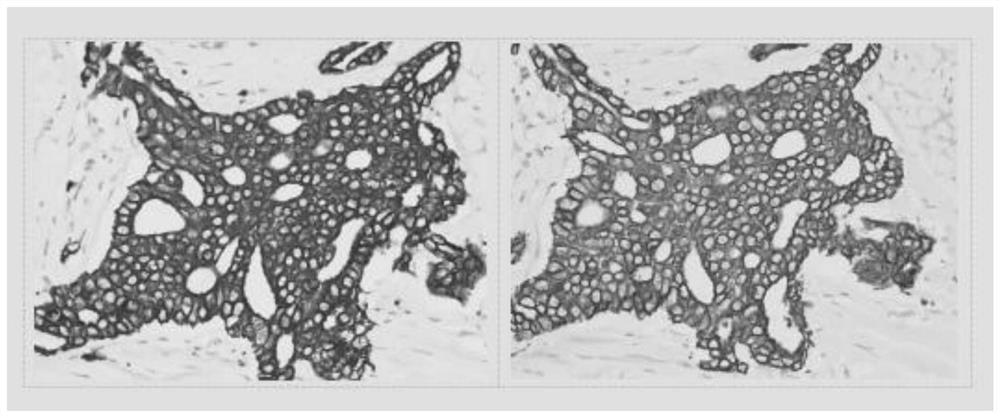Monoclonal antibody against CK8 protein and cell strain, preparation method and application thereof
A monoclonal antibody and hybridoma cell line technology, applied in the field of biomedical engineering, can solve cryptogenic liver cirrhosis and other problems, and achieve highly specific effects
- Summary
- Abstract
- Description
- Claims
- Application Information
AI Technical Summary
Method used
Image
Examples
Embodiment 1
[0019] Example 1 Polypeptide Synthesis and Chemical Coupling with Carrier Protein
[0020] According to the sequence and secondary structure analysis of the protein sequence with the accession number P05787 in Uniprot, the molecular weight of the CK8 protein with a total length of 483 amino acids is about 53 kDa. According to the predicted protein secondary structure (secondary structure) and surface accessibility (Surface Accessibility) parameters through the online server http: / / www.cbs.dtu.dk / services / NetSurfP / , and through its antigenicity index Analyzing the results, the amino acid sequence at position 340-365 was selected as the antigenic peptide for chemical synthesis (its sequence is shown in SEQID1 in the sequence listing), and for the convenience of coupling, a cysteine was added to the carboxyl terminus of the antigenic peptide for Provides for sulfhydryl coupling. The coupling steps are as follows:
[0021] Select the maleamide-activated keyhole limpet hemocyan...
Embodiment 2
[0023] The establishment of embodiment 2 hybridoma cell lines
[0024] 1. Immunity
[0025] The cross-linked polypeptide in Example 1 was emulsified with complete Freund's adjuvant (Sigma, F5881), immunized 3 ICR mice (purchased from Beijing Weitong Lihua Experimental Animal Technology Co., Ltd.), and each mouse was injected subcutaneously in the abdomen. Rats at 6 o'clock, the dose is 20μg / only. Immunization was boosted every 14 days, and the antigen was emulsified with Freund's incomplete adjuvant (Sigma, F5506) at a dose of 20 μg per mouse. 7 days after the third booster immunization, indirect ELISA (wavelength 450nm) was used to detect the polyantibody titer of the anti-immunogen in the mouse serum. 20μg / only.
[0026] 2. Cell Fusion
[0027] Aseptically prepare the mouse splenocyte suspension that reaches the immune standard, mix it with mouse myeloma cell sp2 / 0 (ATCCNumberCRL-8287) at a ratio of 5:1, and centrifuge at 1500rpm for 5min. After the supernatant was disc...
Embodiment 3
[0030] Example 3 Preparation of monoclonal antibody by ascites induction method
[0031] 1. Ascites preparation
[0032] The cells in the logarithmic growth phase were washed with serum-free medium and suspended, counted about 5×10 5, 1ml. The suspended cells were injected intraperitoneally into mice previously sensitized with paraffin oil. Ascites collection was started 7 days later. The removed ascites was centrifuged at 4000rpm for 10min at 4°C. Carefully suck out the ascites in the middle and collect in a centrifuge tube, and store at 4°C or -20°C.
[0033] 2. Purification of monoclonal antibodies
[0034] Antibody was purified from ascitic fluid by HiTrap rProtein A FF (GE Company) affinity chromatography according to the instructions. The purity was identified by SDS-PAGE gel, and the concentration was determined by Bradford method. Purified antibodies were stored at -20°C.
PUM
| Property | Measurement | Unit |
|---|---|---|
| molecular weight | aaaaa | aaaaa |
Abstract
Description
Claims
Application Information
 Login to View More
Login to View More - R&D
- Intellectual Property
- Life Sciences
- Materials
- Tech Scout
- Unparalleled Data Quality
- Higher Quality Content
- 60% Fewer Hallucinations
Browse by: Latest US Patents, China's latest patents, Technical Efficacy Thesaurus, Application Domain, Technology Topic, Popular Technical Reports.
© 2025 PatSnap. All rights reserved.Legal|Privacy policy|Modern Slavery Act Transparency Statement|Sitemap|About US| Contact US: help@patsnap.com



